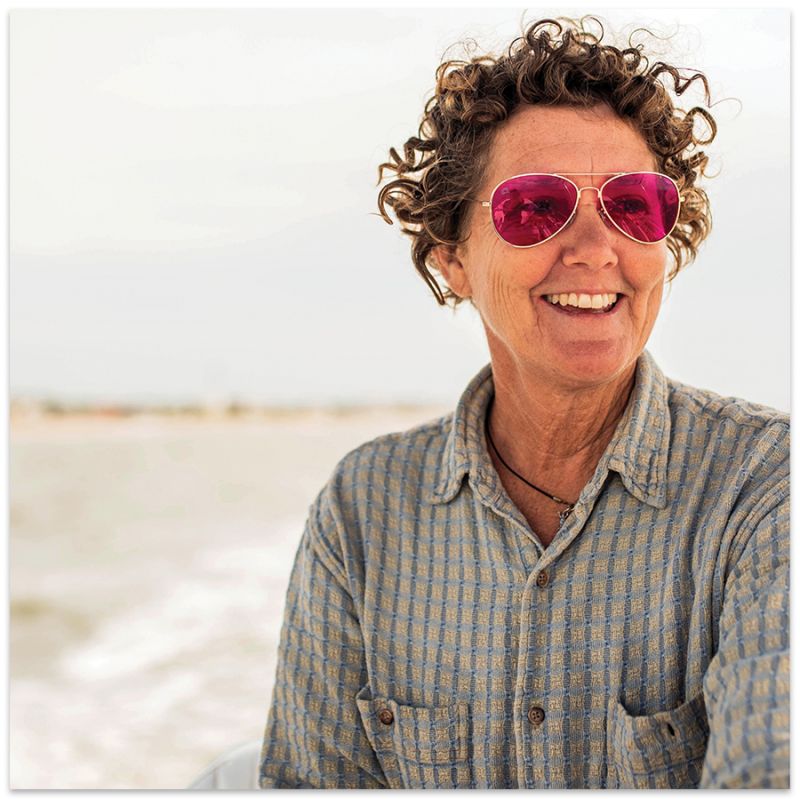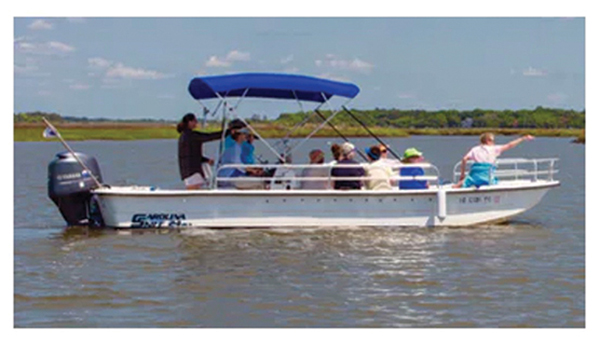Learn how the tour company promotes Gullah-Geechee culture

More about Meg Hoyle, Born: 1969 in Greenville - Lives: Edisto Island in a house her grandparents purchased in 1964 - Career: Founder and owner of Botany Bay Ecotours - Volunteers: With Kiawah Island Diamondback Terrapin Research Project and as a mentor for middle-and high-school students
Meg Hoyle has studied sustainable hunting in Kenya and Zimbabwe, researched tropical ecosystems in the Australian rainforest, tracked sea turtles through the Caribbean, and followed guides through the Galapagos Islands. While adventures abroad have shaped the conservationist’s passion for ecotourism, Hoyle’s ethos flows from a deep connection to the Lowcountry creeks where she grew up. “I’ve traveled to Kenya, Zimbabwe, the Great Barrier Reef, and we have something just as amazing right here in our salt marsh system,” says the founder of Botany Bay Ecotours. “It’s easy to appreciate the beauty of the Lowcountry from a distance, but I want to get people out in these estuaries for an up-close look.”
Aboard a 24-foot Carolina Skiff, Hoyle immerses visitors and residents in the ecological and cultural treasures of the sea islands. Beyond dolphin pod observations and sunset cruises, the captain also partners with local entrepreneurs to offer unique Gullah-Geechee experiences. “With 250,000 acres of the ACE Basin under permanent conservation easement, there’s always something to explore,” she says. ”The world is our oyster, so to speak.”

Botany Bay Ecotours offers dolphin tours, sunset cruises, and more.
CM: What drew you to ecotourism?
MH: I grew up on John’s Island before the local food movement, steeped in a tradition of gardening, fishing, shrimping, and crabbing. The only way to protect that lifestyle is to continue guarding our natural resources. People have used the ACE Basin’s natural resources for 5,000 years. This land and these waterways are not untouched—they’ve been touched for generations—we just need to choose to do it sustainably.
CM: How can we balance tourism and environmental responsibility?
MH: We need to accommodate visitors to the coast but also put limits on it so they understand what they’re seeing and don’t destroy it in the process. We can’t dump people on a beach to walk through nesting shorebird habitats and disrupt them without even knowing it. I love the simple charge of picking up a piece of trash. My glamour job at the DNR was necromancy—figuring out why sea turtles were washing up dead. One had a Coca-Cola can in its stomach. When I see a piece of litter, I think, “What if I never picked that up?”
CM: How does Botany Bay Ecotours promote Gullah-Geechee culture?
MH: My friend Marvetta Hutchinson is an amazing cook, but in Edisto, she couldn’t get a job paying more than minimum wage. So, when my customers said, “show us more,” I asked if she’d share her cooking. These foodways came from West Africa into Charleston and then spread across the country. People love good local food, but it’s important that the history be involved.
CM: How have you seen Edisto Island change?
MH: Since I came to Edisto in 1999, there has been more and more development. The island used to be almost entirely African American; now, it’s primarily Caucasian. And when you pave more than 10 percent of an area, it starts impacting the surrounding waterways. DHEC has already closed all of the internal creeks for shellfish harvesting because they’re no longer safe.
CM: What sorts of challenges did your company face through the pandemic, and how did you navigate those?
MH: It was tough because our number-one selling tours were public tours where people buy a seat. I could sell 12 tickets with people sitting next to each other, but we couldn’t do that anymore. We had to go to private tours, which I never wanted to do because I wanted it to be accessible to anyone. I was overwhelmed at the response. People wanted to get outside and be outside with their families to enjoy time together in a place where they felt safe. We’re back now to public tours, but I think we can ride this as it comes and goes.
CM: How does your experience as an endangered species observer last year feed into your work?
MH: A lot of it helps me see the global connection of where we are. When I was in the Galapagos, I got to see a shorebird called a whimbrel that feeds in our marshes for a short time so it can make it from the Arctic to South America. I got to see their incredible migration firsthand. We have just as many amazing examples of just wildlife, flora and fauna, right here in the Lowcountry. I enjoy the opportunity to travel and go to new places, but it’s nice to come home and remember that wildness is right here in the ACE Basin. You don’t have to go around the world to see the importance of our area. We’re not removed from that larger system, but connected through the water and flyways.
CM: Why do you feel it’s vital to educate people about the Gullah/Geechee culture?
MH: Because historically, they’ve been ignored and shamed for their culture. It was a way to try to erase it. We know how environmental justice goes. There’s a very vibrant Gullah-Geechee community in the Lowcountry. We need to make sure that those same sort of systemic racism decisions aren’t going to overwhelm and wipe out those communities. We can’t remove their culture, that’s inside of them, but they can be removed from their homes. It would be nice if that stopped.
CM: What knowledge do you hope to share with tour-goers?
MH: An understanding of our connections—not just with the animals in the marsh, but to the history, culture, and people of this place. Like the pluff mud that once fertilized cotton growing on plantations—those stories still impact us today as we address economic disparities in communities where people’s ancestors were once enslaved.